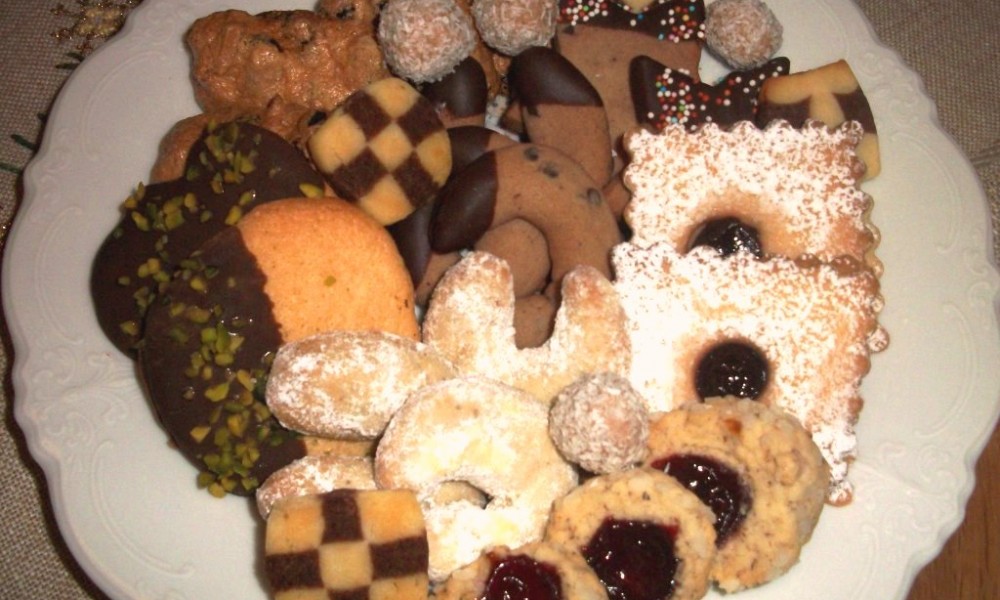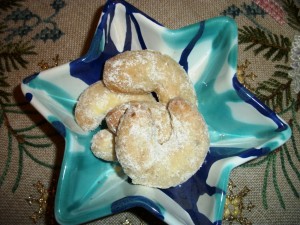Viennese Christmas Cookies – Traditional Christmas Culinary Delights

Are you in the Christmas spirit yet? If not, have you already baked Christmas cookies? At first glance, this question seems to be lacking a context, yet I promise you: Once the scent of homemade Christmas cookies permeates your home, the Christmas spirit will arrive all by itself. At the Schick Hotels & Restaurants, these sweet accompaniments during the (pre-) Christmas season are part of every Christmas party and the holiday menus. Traditional or modern, cookies, confectionery or special Austrian fruit breads, it will warm your heart (not to mention stomach) when these sweet Advent and holiday accompaniments are on your table.
Origins and history
The ancient Egyptians already placed small honey cakes into the graves of the deceased. In India, too, already in 3000 BC, people made delicacies from nougat and marzipan (almond paste).
The modern form of cookies has its origin in ancient Rome. There, in the third century BC, the so-called waffle biscuit was created, which was unsweetened.
The Celts celebrated winter solstice during the night from December 21 to December 22. Archaeological excavations and early depictions prove that they baked flatbreads made of milled grains and honey, which they believed protected them from evil demons and, as an offering, won the grace of the gods.
Christianity, which was emerging at the time, took on these traditions, though it changed the meaning of the shapes. In place of offerings and shaped breads, “Christmas fruit breads” (Christstollen in German) were baked. Animal-shaped cookies were reminiscent of the animal offerings in the early Christian era.
The first Christmas cookies, as we know them today, are presumed to have been made in medieval monasteries. Monasteries also dealt with rare spices from the Orient such as cinnamon, cloves, nutmeg, ginger and cardamom. The religious background of the birth of Jesus offered sufficient impetus for the festive baking.
It is also said that baking for Christmas goes back to the superstition that evil spirits of the “wild hunt” in the nights between Christmas and New Year’s Day could be driven away by appeasing them with sweets.
Baking cookies as is done nowadays developed in parallel with the consumption of coffee, tea and cocoa in the 17th and 18th centuries. Since the founding of the first Viennese coffeehouse in 1684, countless types of cookies and pastries were created to emphasize the flavor, scent and enjoyment of coffee with their ingredients and fillings.
Cookies were particularly popular among the ladies in high society, who served them at their coffee parties. Like all confectioneries, cookies were a luxury item until the beginning of the 19th century due to the high prices of their ingredients such as sugar, almonds and cocoa. Once it became popular to obtain cheaper sugar from the sugar beet, baking cookies also spread to more simple households. The cookies now typical during Christmastime likely hearken back predominantly to the Biedermeier era and the Vienna Ringstrasse epoch.
Austrians’ favorite cookies
The classic Vanillekipferl (vanilla crescents) take first place on the popularity scale, followed by Linzer Augen (Linz cookies, literally “Linz eyes”) and Rumkugeln (rum balls). Kokosbusserl and Nussbusserl (“coconut kisses” and “nut kisses”) as well as shortcrust cookies round out the top 5.
Here are some details on Austrian cookies:
Vanillekipferl:
For centuries, vanilla was among the world’s most expensive and precious spices. At the end of the 19th century, chemists Wilhelm Haarmann and Ferdinand Tiemann discovered a synthetic, cheaper substitute for vanilla, “vanillin,” as it is called. Vanillakipferl soon became one of the most successful of all Christmas cookies and tea biscuits.
Linzer Augen:
Linzer Augen are made from two circular pieces of shortcrust held together with marmalade. The upper piece has either one hole in the middle or three holes, depending on the size of the cookie.
Macaroons (Busserl):
Almond macaroons, or just macaroons for short, came about in Venetian monastery kitchens during the 8th century. Their shape allegedly hearkens back to a monk’s navel. In the 16th century, they came to France in the luggage of the Queen of France, Katharina of Medici, who was from Florence; this is how they became known and were baked outside of Italy. In Vienna, macaroons are also called Mandelbusserl (“almond kisses”) and coconut macaroons Kokosbusserl (“coconut kisses”).
Tea biscuits and Christmas cookies:
By tea biscuits and Christmas cookies is meant crispy or shortbread cookies which are manufactured in various shapes from all kind of dough and mixtures.
Whichever cookies and Christmas cookies happen to be your personal favorites to bake and eat, Christmas cookies are an inseparable part of Advent and Christmastime. The poet and writer James Krüss put it in a nutshell with his amusing poem “The Christmas Mouse.” With a small excerpt from this poem I’d like to wish you
happy holidays (WITH delicious Christmas cookies and WITHOUT Christmas mouse)!
So it is from Christmas cake
Mother had stashed away,
The very best of all she’d baked
Was gone on Christmas day.
Then everyone proclaimed aloud
“I’m not the one who took it!
Last night, both sly and proud
“Twas the Christmas mouse who snook it.”
(From: James Krüss, “The Christmas Mouse.” The complete original German poem can be read here:
http://weihnachten.tagesspiegel.de/die-weihnachtsmaus.html ,
For info on James Krüss, see: https://en.wikipedia.org/wiki/James_Krüss )
Sources:
Tee- und Weihnachtsbäckerei, registration number 183. Authors: Dipl. Päd. Ludwig Mann, Daniela Trenker B.A., Mag. Doris Reinthaler, Mag. Eva Sommer https://www.bmlfuw.gv.at/ ;
Felber Bakery http://www.felberbrot.at/ .










